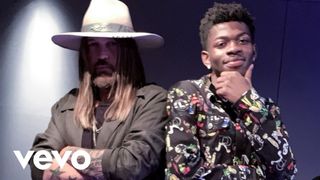Bias
Old Town Road: A Story of Black Life and Allyship in America
Lil Nas X Song enters 11th straight week at No. 1.
Posted June 18, 2019 Reviewed by Lybi Ma

Unless you have been away or tuned out, you likely know that Lil Nas X’s song, “Old Town Road” (featuring Billy Ray Cyrus), has been the No. 1 song on the Billboard’s “Hot 100” chart for 11 straight weeks.
Lil Nas X, 20, born Montero Lamar Hill, is a self-made rapper from Atlanta who created the chart-topper with a country-style song paired with a 57-year-old White country music star.
It has a catchy beat and hook and has been turned into scores of videos by TikTokers and YouTubers. Lil Nas X also recently showed up for a surprise performance for Cleveland fifth graders, who sang the song in their talent show and their teacher posted it to Twitter.
Of course, there are naysayers and resistance, claiming appropriation, after the jeans brand Wrangler debuted its Wrangler Lil Nas X Collection. Some country fans are calling for a boycott of the jeans since the partnership, a move his fans criticize as racist.
This demonstrates that Lil Nas X’s “country-trap” song has not only gone viral, but it has had a nontraditional rise to fame. Stunningly, Lil Nas X has done something other musicians and politicians, and all Americans, seemingly struggle to do.
He has brought together millions of people from completely different demographics across age, race, and gender to agree on something—love for a song. However, the story of how his song became No. 1 is emblematic of Black life in America, a call for diverse voices in all spaces, and allyship.
“Old Town Road”’s rocket into fame is a classic story, undeniably American in nature, representing a microcosm of American society.
Prior to his mega-fame, Lil Nas X says he was broke, couch-surfing, and trying to launch his career.
Many Black Americans have similar realities, with 20 percent falling under the poverty line, compared to 8 percent of Whites in 2017. More than 33 percent of Black children are that group, while 11 percent of White children fall below the federal poverty line.
But however unlikely, Lil Nas X came into his own success as a musician by debuting on the Billboard’s charts and ultimately landing at No. 1. However, for the majority of Black children, they are less able to catapult themselves into financial security.
According to a recent report released by the Brookings Institute, Black children are less likely to experience upward economic mobility. Children in the lowest income level are 17 percent more likely to stay there as adults. Even for Black children at the top income levels, they are still more likely to move downward.
However, Lil Nas X’s success story doesn’t end there. Shortly after the song landed on the charts, his song was later removed from Billboard's charts citing that the song lacked elements of “today’s country music.”
Many attributed this literal takedown as racism and genre segregation; however, Lil Nas X attributed this to genre purity. He thought the backlash was more because his song was not country “enough” to country purists.
This is often the scenario when Black people align with social norms routinely registered as “success,” they are still less likely to benefit from those successes. These traditional social norms that contribute to the “success sequence” include graduating from high school, having a full-time job, and having children after marriage after age 21.
As a pediatrician and an African American woman who has checked off all these social norms, I also know I was afforded a great many opportunities not experienced by my peers that allow me to sit comfortably where I am. However, this is frequently not the case for others.
The Brookings Institute recently reported that even when Black Americans who hit all those “norms,” only 59 percent, compared to 73 percent of their White peers, reach middle-class status. This may be attributed to institutional racism in the educational system and the labor market, among other factors.
The U.S. Census Bureau reports that in 2017, the median average income for Blacks was $40,258, compared to the median average household income for Whites at $65,273. Hispanic-led households had a median average income of $50,486.
Following the Billboard removal, Lil Nas X elicited the help of Cyrus, a White and well-established country singer, to remix the song. Cyrus could be identified as an ally, that is a person of privilege working in solidarity with those in a marginalized group. However, the common Black person probably does not have an ally who can directly benefit their personal or professional lives.
According to the U.S. Census Bureau, Black people and other people of color are more likely to be living in poverty, with 21.2 percent of Blacks living below the poverty line in 2017, compared to 10.7 percent Whites and 18.3 percent Hispanics.
The American Dream theory insists everyone can pull themselves up and be successful. Yet in real life, when they do, they are often met with resistance or blocked from realizing their full potential. This is likely in part due to overt and subtle racism, intentional and unconscious bias by institutions, systems, and individuals, demonstrated by a lack of mentors, sponsors, allies, and opportunities.
Four years following the election of President Barack Obama, there was an uptick in anti-Black sentiments. While millennials are revered for their progressive views, there has not been a change in White racial resentment. These sentiments are becoming so pervasive that social media sites like Twitter are deciding if White supremacy groups and nationalist groups should be banned.
When White people see these injustices happen, stepping up to stop these insults could open doors previously closed and allow people of color to reach these heights. Yet, for many, even the “smallest amounts of racial stress” can “trigger a range of defensive responses,” author Robin D’Angelo writes in her 2018 book, White Fragility: Why It's So Hard for White People to Talk About Racism.
D’Angelo continues that “White fragility is born of superiority and entitlement.” She adds that it is “a powerful means of White racial control and the protection of White advantage.”
Certainly, Black people should not need the help of White people, nor should White people be seen as saviors. However, within American culture, having allies is exceedingly critical.
If there existed equal access to opportunities—including education and career development—what other genius collaborations, remixes, or reinventions would emerge?
“The only way to undo racism is to consistently identify and describe it—and then dismantle it,” writes Ibram X. Kendi, director of the Antiracist Research and Policy Center at American University, in his upcoming book, How To Be An Antiracist.
To be sure, the story of how this one song came to be could simply represent one young adult attempting to be famous and be heard. Still, there is a larger message that industries including science, engineering, medicine, and many others need to hear. If all these fields continue to look and be homogeneous, they are missing the genius many others have to give.
Lil Nas X has successfully unified and integrated groups of people that many may have thought would be impossible.
Everyone needs to try "til we can’t no more," as the lyrics state. It’s more than a song. It’s a representation of being Black in America.




